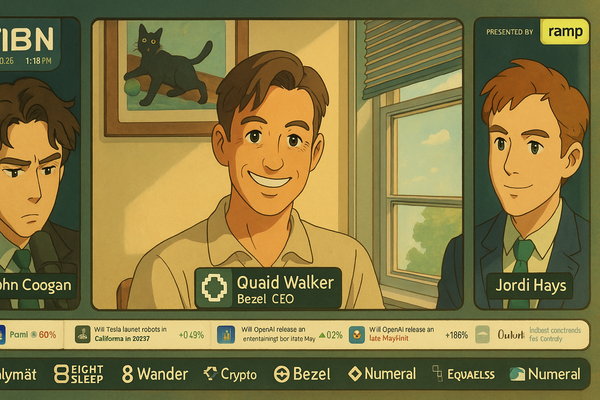The Future playbook for sustainable publishing
The UK specialist publisher is targeting the US market


Hope everyone had a good end to summer, other than those in the Southern Hemisphere. Check out the pilot episode of a new podcast I did with Troy Young from People vs Algorithms. Let know what you think: bmorrissey@gmail.com. Also, if you’re not already, please subscribe to receive The Rebooting every Tuesday and Thursday.
This week:
- On The Rebooting Show, I spoke to Zillah Byng-Thorne, CEO of Future, a remarkably successful UK-based specialist publisher that probably doesn’t get enough attention as it should.
- The shifting tides of the digital ad business.
- Thoughts on the end of the Long Summer.

The Future playbook for sustainable publishing
The most successful publishers at this time tend to share some common traits:
- A focus on niche areas, both consumer and business-oriented
- Diversified business models
- Operational excellence
Future is one of them. As a collection of over 200 specialist titles that range from gaming and tech (Tech Radar) to homes (Homes & Garden) to beauty and fashion (Who What Wear) to B2B (SmartBrief), Future has established itself as one of the UK’s most successful publishers. (Its current market capitalization puts it at 8x the value of BuzzFeed.) But for its future growth, Future is betting heavily on the U.S. market, which CEO Zillah Byng-Thorne noted to me is five times the size of the UK. The U.S. already represents 35% of Future’s audience as well as 38% of its revenue.
“As we then started to think about how we grow, I [said], Hang on a minute, we're very UK-focused, but the US is five times the size. It’s the same enthusiasm. It's still video gamers. It's still golf players. So why are we thinking about this market differently? Why are we thinking about geography when the internet doesn't have a geographical divide. And so what we said was let's stop thinking about boundaries and borders and start just thinking about our enthusiasm, our audience, and let's write content for wherever they are within the English speaking domain.”
Byng-Thorne is something of a newcomer to the media business. An accountant by training, she joined Future in 2014 as its interim CFO and soon was appointed CEO, tasked with turning around a magazine publisher that, like its peers, was struggling to make a transition from print to digital. Her turnaround plan – she initially cut 40% of employees as the company was recording a £35 million loss in 2014 – has become something of legend, setting the stage for a remarkable financial turnaround as Future became an early adopter of using its niche focus in high-intent categories to drive transactions. The shift to commerce – it is now 34% percent of Future’s revenue – was informed by her previous time at Autotrader, which made the leap from car magazine to marketplace.
“Autotrader started out as a magazine company in the UK. We basically set a sales team up against the magazine team to sell digital, which felt like heresy at the time, but it really helped us drive forward in those early days. That transition from print to online, if we had not done it to ourselves, someone else would've done to us. And so you've got to be prepared to disrupt, and then you also be really clear that you're delivering on your promise. Are you delivering on your promise to your consumers? Are you delivering on your promise to your clients?”
Some highlights from my discussion with Zillah on The Rebooting Show:
- Figure out your “right to exist.” The reality of the market is no company can take anything for granted. Zillah recounted how her first year at Future, which was on what she describes as a decade-long decline, the key question to answer was: “What’s our right to exist?” Her conclusion: Put the company on firmer financial footing, double down on the expertise embedded in the brands.
- Build multiple revenue streams. Future was struggling with the transition from print to digital when Byng-Thorne took over. Beyond that, the diversification needed to be done on the digital side as well since many publishers were overly reliant on digital advertising. Commerce was a way to make money from audiences without the ups and downs inherent to the ad business. Future’s revenue is now roughly split in thirds among advertising, commerce and direct revenue from the audience.
- Have an acquisitions playbook. Future has spent over £1 billion on acquiring companies since Byng-Thorne took charge. In the past year alone, it has acquired four companies, including Who What Wear and Dennis Publishing and MarieClaire.com. “We integrate fully. I know some of our competitors don't all integrate fully, but for us, it was really important that it's one Future, one tech system, one sales team, one way of working.”
Check out the full episode on Apple Podcasts, Spotify or Anchor. Thanks to Jay Sparks from Pod Help Us, who produces The Rebooting Show. If you have podcast production needs, get in touch with Jay.

House of Kaizen collaborates with publishers worldwide to build more sustainable businesses with best practices and experimentation for better acquisition, retention and lifetime value. Matt Cronin, founding partner of House of Kaizen, give his insight into goal alignment, a critical feature of sustainable subscriptions programs:
If there are multiple definitions of success across your team, customers and collaborators, you’ll never be able to achieve it.
Sustainable growth comes from delivering on both the subscribers’ goals and business goals throughout each stage of the product journey. We call this goal alignment, our clients have referred to it as Business Therapy.
Customer research reveals the subscriber goals while introspection clarifies the company goals, then KPIs can be defined to represent measurable success for both parties throughout the journey.
When the KPIs don’t align with the customer’s values and motivations, then the growth strategy will not be sustainable
Learn more about how House of Kaizen helps publishers and marketers build sustainable subscriptions businesses — and get in touch with Matt directly.

Digital advertising’s reboot
The digital advertising market has been stagnant for some time. Having covered the early days of internet advertising, I became used to the rapid innovation cycles of what was then the open web. There was a degree of chaos, but many companies were pioneering new ways of doing advertising. I can remember learning about programmatic advertising initially at the launch of Right Media and believing it would completely change the industry. Those kinds of big shifts have mostly stopped as the market consolidated among a few big tech platforms.
There’s a good case to be made, however, that we’re on the cusp of real change and a new period of shifts in the market due to a confluence of forces.
- Privacy is no longer the last panel before cocktails. This industry paid lip service to privacy for decades, and the bill has come due. Reading through the Federal Trade Commission’s complaint against Kochava, you’re left wondering how many companies could have gotten in the FTC’s crosshairs and why Kochava. The way regulators work is they send signals to the market, and this is a clear signal. The current moves to crack down on the rampant use of consumer data is not a side issue and will force change.
- Facebook has never looked weaker. Leave aside the fact that Zuckerberg is talking tough and spending his free time grappling instead of doing goofy hoverboard stunts. Facebook sure feels on a path of decline. Apple’s power play around “privacy” with IDFA, TikTok’s threat to Instagram and the rough rollout of its metaverse ambitions combine to make Facebook vulnerable.
- Apple and Amazon have different philosophies. You don’t have to be much of a cynic to roll your eyes at Apple’s breathtaking move to carve off a big piece of the digital advertising industry. It appears inevitable Apple will become a digital ad giant in short order, already seeking to double its advertising workforce. Amazon has already traveled this path. Both companies, while different, will bring new approaches to their ad products that, ideally, reflect their consumer-centric ethos. Apple can hardly kneecap competitors over privacy concerns and then turn around and engage in the same practices. (OK, maybe it can, but I believe it will end up building a more consumer-centric ad products than, say, Facebook.)

Final thought: The Long Summer
One of my favorite spots in Miami is Stiltsville, a seafood place in Sunset Harbour, across from the Biscayne Bay. It plays the surfer movie “Endless Summer” on a constant loop. Having spent more time here than I'd ever have imagined, I can relate. For me, it’s now time to leave Miami and return to New York. The Long Summer is ending. The fall and winter look set up to be a harsh return to reality on several fronts.
- The last stand for the office. One publishing CEO told me that September was it. The lax approach to the return to office will end and “three days means three days.” The alternative is leaving the company. Goldman Sachs is leading the way with its effort to completely return to Before Times. We’ll see many companies take these stands, sitting on long leases for expensive office spaces or wanting to signal to clients their cubicle dwellers “eat nails for breakfast.” The market will sort this out, since many companies without those leases will use a more flexible approach as leverage to attract people who might otherwise prefer the safety of a big company.
- A rough winter awaits. I don’t think people in the US appreciate how dire the energy crisis is going to be in Europe this winter. There are even game show prizes in the UK for paying contestants’ energy bills, and the outgoing prime minister urged people to replace their kettles. The watchword in France is “energy sobriety.” An economic recession appears inevitable in Europe with soaring gas prices already leading to protests and warnings of coming civil unrest. Even if the virus doesn’t roar back in the US, the continued lockdowns in China and rising interest rates to quell inflation will dent overall economic growth, if not cause an outright recession. Many of the decisions made during the pandemic to pump trillions into the economy have set up a monster bill that’s going to be paid in the form of continued price hikes that strain the economy.

Thanks for reading. Please send a note with your thoughts for future podcast topics and feedback on what you’d like to see from The Rebooting. You can respond to this email or send me a note at bmorrissey@gmail.com. If you’re interested in sponsoring The Rebooting to reach top publishing executives, check out the sales kit and get in touch.




